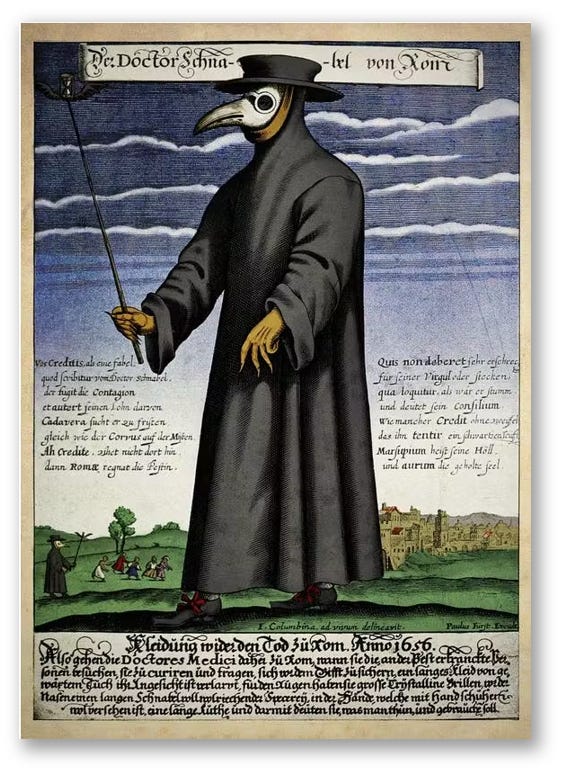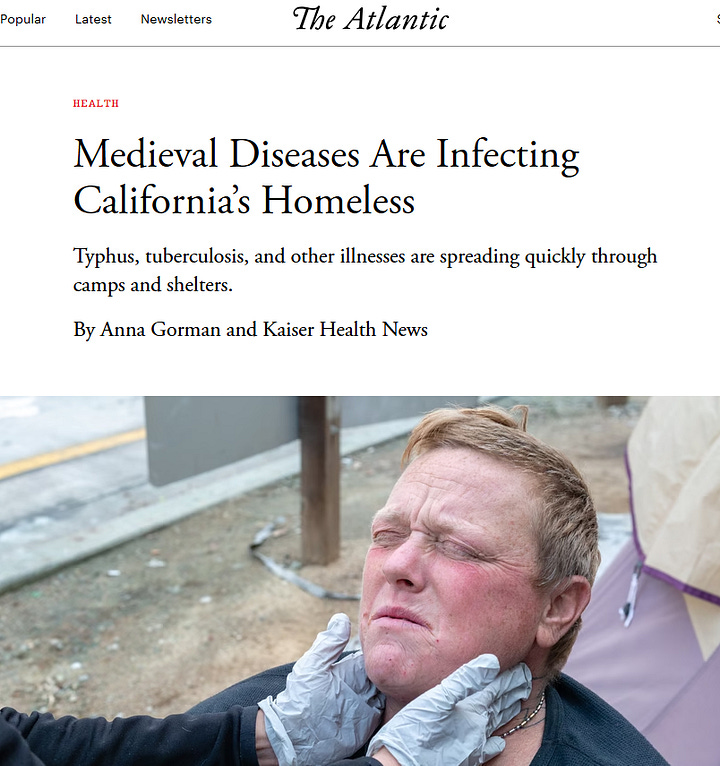NOTE: The opinions expressed here are those of the author only and are not intended as medical advice. Please check all claims independently, and consult a healthcare professional before taking any health-related action.
FYI: If you missed our introductory post on this subject, click here to read “The Monster under the bed.”
No doubt most of us shudder at the mere thought of what we imagine was the most gruesome disease ever to affect humankind in the history of the world.
Horror movies use people-eating zombies to simulate what it must have been like when plague threatened whole populations.
Monty Python, on the other hand, prefers the literal approach, showing corpse collectors being paid to haul away the latest plague victims.
What is plague?
Even though it has many names—plague, bubonic plague, and Black Death—they all refer to the same disease: infection by the bacterial pathogen Yersinia pestis.
Keep these two points in mind as we continue:
Plague is just a bacterial infection, like countless others doctors see every day.
Today we have lots of antibiotics that can kill Yersinia pestis bacteria.
The key for this bug, as with most bacterial infections, is to get a quick diagnosis and proper treatment.
The risks of plague in the US today
The risks are ridiculously low of just catching plague in the US. And it’s even more rare to die from it.
As you can see, the highest bar on this chart represents 17 cases...with only one death that year.
And the worst year, 2015, had only 4 deaths.
To put it in perspective:
You are 10,500 times more likely to die in a car accident than from plague in America.
But just to be safe...
Even though the risk of plague death today is absurdly low, you should know what to look for and what to do.
The three forms of plague
Depending on what part of the body is affected, this pathogen can manifest in multiple ways, creating the illusion of separate diseases.
The forms are: bubonic, pneumonic, and septicemic plague.
1. Bubonic
Bubonic plague shows itself as sometimes discolored or purplish bumps called “buboes.”
These buboes are actually swollen lymph nodes. That’s why they appear primarily along the sides of the neck, the armpit, and groin where lymph nodes cluster.
The bubonic form of plague may be the most survivable, partly because its symptoms (buboes) are so obvious that even doctors who have never seen plague in patients will remember these signs from medical school.
Remember though, even the common cold can cause swollen lymph nodes. Your doctor should be able to spot the difference.
2. Pneumonic
Pneumonic plague is the only form that can spread from person to person.
This form of plague is typically a complication of an untreated primary Y. pestis infection. If the infected person is treated properly, it won’t progress to this stage.
Once in the lungs as pneumonia, plague can spread to other humans like a cold, through coughing or sneezing or other close contact with the infected person.
If the infection has been neglected, this complication can make it harder to treat.
And as we know, complications of anything can be dangerous.
3. Septicemic
Septicemic plague is the worst-case scenario, just as sepsis from any infection presents urgent and difficult challenges for healthcare teams.
Septicemic plague can result directly from a flea or animal bite that allows Y. pestis to directly enter the bloodstream and flood the patient’s whole body with the bacteria.
It can also result as a complication from failure to treat one or both of the previous forms properly and quickly.
In other words, septicemic plague is simply the dangerous end-stage of a highly treatable, but either neglected or improperly-treated infection.
To put it into perspective: Even a simple measles infection, when complications are not properly treated, can lead to pneumonia complications, or to sepsis, and ultimately death.
Sepsis from any infection can be deadly.

How plague spreads
As described above, there are generally two modes of transmission for Y. pestis plague.
Directly from the bites of fleas or infected animals
Exposure to a person with pneumonic plague
Direct transmission
The bacteria is typically spread directly though the bites of infected fleas carried on rats and other animals. It can also be transmitted by the bites of the infected animals themselves
Y. pestis can be carried by squirrels, rabbits, rats, prairie dogs, deer, camels, and occasionally even dogs and cats that are in contact with wild animals or their fleas.
That’s why the handful of cases the US sees each year are typically contracted in outdoor settings.
Human-to-human transmission
In super-rare cases where the disease has progressed to the lungs (pneumonic plague), the infected person can spread Y. pestis through the air to others by coughing or sneezing.
Three main waves of plague pandemics
Plague history is divided into three main time periods:
Plague of Justinian (541-750 AD)
Black Death (1331-1855)
Third pandemic (1855-1960)
It was the Black Death period most of us picture when we think of plague. This was primarily the mid-1300s when it decimated populations in Europe and Asia, as well as those along the Silk Road and shipping routes.
But the third pandemic persisted from the late 1800s all the way to 1960 in parts of India and China.
Why was plague so deadly in its heyday?
What all these outbreaks had in common was:
Living conditions were abysmal, and people were generally unhealthy.
Medical care was worthless at best, deadly at worst.
Conditions that foster the spread of plague
Just like many other infections that used to be deadly, plague thrives in dirty, unhealthy environments.
Conditions that promote the spread of plague include:
Poor nutrition
Little or no access to clean drinking water
Lack of cleanliness
Constant contact with sewage and animal waste
Infestations of rats and fleas
Curiously, these same unhealthy conditions exist in modern places and times … in homeless camps, for example.
As a result, we now have new outbreaks of long-gone diseases (like plague).


Medical care during history’s worst plague waves
Treatments for plague ranged from marginally helpful, to silly or worthless, to outright dangerous.
Here, in no particular order, are some of the ways medieval people handled plague:
Chicken butt on the buboes. A healthy, live chicken’s plucked butt would be pressed against the patient’s swollen lymph nodes (buboes) and strapped there. When the chicken began to look sick, it was removed, washed, and tied back on until either the patient or the chicken died.
Unicorn powder. Must have been pricy stuff because only young virgin maidens could subdue the unicorns to get their horns for the powder.
Drawing bad air to worse air. The thinking (?) here was that, by sitting in the foul air of sewage pits, patients could entice the “bad air” or “miasma” (actual medical terms) that caused their sickness to leave their bodies and join the worse air of the sewage.
Human waste rubbed into the buboes. (Shaking my head.)
Sweating. This is the only treatment that may have potentially done some good. High fevers, exaggerated by situating patients near hot fires, might actually have helped fight off infections naturally.
Add to those the age-old favorites: arsenic, mercury, opium, and blood-letting that remained popular into the early 20th century.
How to prevent plague
It’s not rocket science.
Avoid places where wild animals live.
Wear bug repellant, high shoes, long pants while in wild areas.
Wear heavy gloves to handle wild animals (or don’t handle them).
Keep your pets away from wild areas and wild animals.
Use antiseptic mouthwash gargles and nasal sprays if you’ve been exposed to someone coughing or sneezing.
See a doctor if you have grossly swollen lymph nodes.
A curious legacy of plague
A 2022 study found that survivors of the Black Death in London and Denmark had genetic mutations that may have helped them fight off Y. pestis.
The downside is that this mutation, passed down through generations, may be responsible for increasing descendants’ risk of autoimmune conditions like Crohn’s disease.
Bottom line on plague
Plague is still with us as a highly treatable bacterial infection. It spreads in unsanitary conditions and, like any infection, is more harmful to those who are already unhealthy.
In the US, fewer than one person dies of plague each year on average (15 deaths in 23 years).
Survival rate with prompt and appropriate treatments is upwards of 95%.
TV sensationalizes plague
An episode of The Resident (S2 E12) deals with an outbreak of plague, originally thought to be flu, in an Atlanta hospital.
The imaginary strain of plague is resistant to all but one antibiotic.
This scenario is fear-mongering at its best for entertainment purposes.
In real life, it would take a “perfect storm” for this to happen:
Patients would have to be in the pneumonic stage (in the lungs) to be able to spread it to other humans … or modern Atlanta would have to have swarms of plague-infected animals and fleas infecting people individually.
The Y. pestis infection diagnosis would have to be missed or delayed for so many patients with the non-infectious, bubonic form to allow the progression of the infection into the transmissible pneumonic form. And bubonic plague is hard to miss.
Plus, there would have to be prior, ongoing circumstances where Y. pestis was encountered often enough to develop resistance to nearly all antibiotics.
As far as I (and AI) could determine, the only place in the world where plague has developed resistance is Madagascar.
There are at least five antibiotics that can kill plague bacteria in the US.
Scary-ometer rating
While plague feels like a screaming 10, it’s really only as scary as any bacterial infection.
However, even common bacterial infections can be life-threatening when the germs that cause them have developed resistance to most antibiotics.
And, by the way, a multi-drug resistant strain of Y. pestis was identified in Madagascar in the mid-1990s. Which means we’d need the strongest (and potentially the most toxic) medicines to kill that particular strain.
We can thank the chronic misuse of antibiotics by doctors (and patients) over the past 50+ years for the drug-resistance phenomenon.
Next up: Smallpox
In MONSTER 2, we’ll demystify another infection that gets our hearts racing for all the wrong reasons.
Stay tuned!
RESOURCES
Plague
https://my.clevelandclinic.org/health/diseases/17782-plague
Human Plague Cases, Fatal and Non-fatal - United States, 2000-2023
https://www.cdc.gov/plague/maps-statistics/index.html
Fatality Facts 2022 - State by state
Black Death survivors gave their descendants a genetic advantage — but with a cost
The History of Plague – Part 1. The Three Great Pandemics
Medieval Diseases Are Infecting California’s Homeless
Official Lies, Bubonic Plague, And California's Homeless Challenge
Evolution of immune genes is associated with the Black Death
https://www.nature.com/articles/s41586-022-05349-x
Medieval Cures for the Black Death
https://www.worldhistory.org/article/1540/medieval-cures-for-the-black-death/










